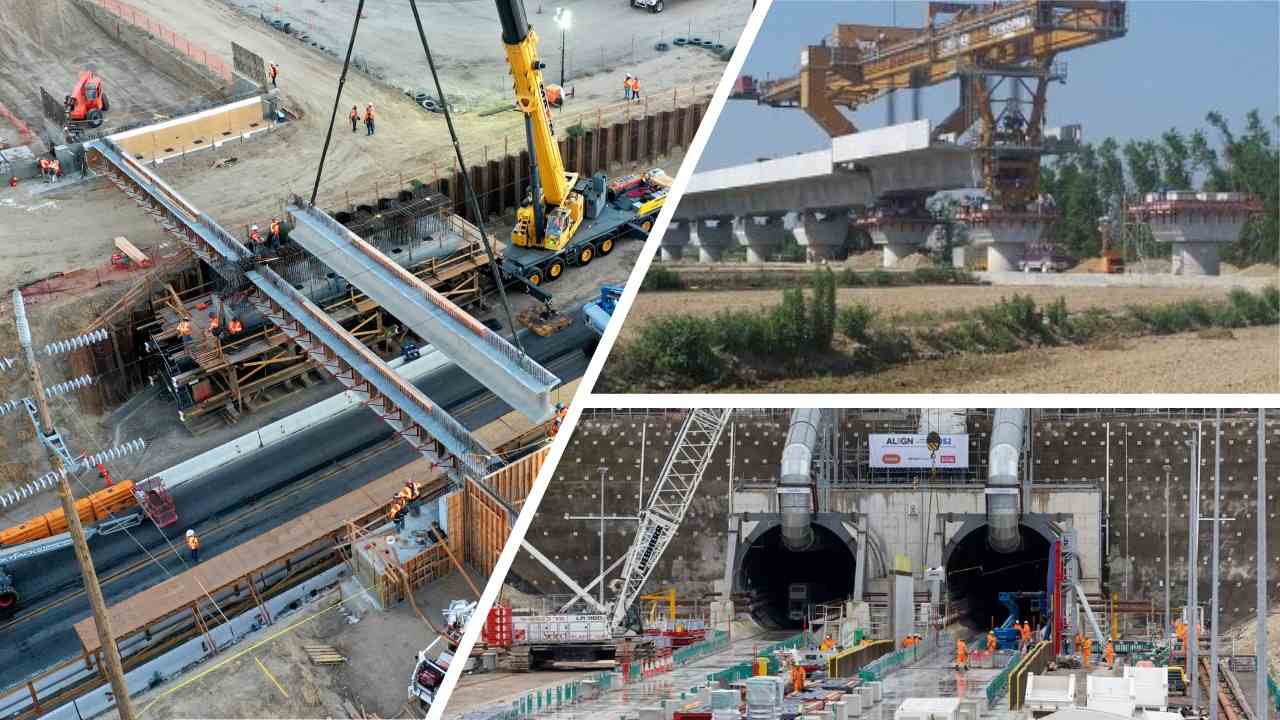Construction Machinery for High-Speed Railway Projects
- By
- Pooja |
- October 29, 2023 |
- Civil Engineering, Pway / Railways, Construction,

Table of Contents
Tunnel Boring Machines (TBMs):
Bridge Construction Equipment:
Overhead Line Equipment (OLE) Installation:
Surveying and Alignment Technology:
Maintenance and Inspection Vehicles:
Urban Congestion and Land Acquisition:
High-speed railway projects are transformative endeavors that revolutionize transportation by providing efficient, fast, and environmentally friendly connectivity between cities and regions. These projects require cutting-edge technology and a diverse range of specialized construction machinery to achieve their ambitious goals.
In this comprehensive post, we will explore the key types of construction machinery used in high-speed railway projects, their functions, benefits, and the challenges they help overcome.
Tunnel Boring Machines (TBMs):
High-speed railway lines often require tunnels to pass through mountains, urban areas, and challenging terrain. Tunnel Boring Machines (TBMs) are critical for excavating tunnels efficiently and precisely, minimizing disruption to the surrounding environment. TBMs cut through rock and soil, creating smooth and consistent tunnels that accommodate high-speed trains.
Track Construction Equipment:
Track construction is a fundamental aspect of high-speed railway projects. Specialized machinery, including track laying machines, ballast regulators, and tamping machines, ensure the accurate and stable alignment of tracks, enabling smooth and safe train operation at high speeds.
Read More:
Top 10 Longest Tunnels in the World
What is Tunnel Boring Machine (TBM)? 9 Important Points
Concrete Paving Machines:
Concrete paving machines are used to construct platforms, stations, and viaducts along high-speed railway lines. These machines lay down precise and uniform layers of concrete, contributing to the durability and stability of railway structures.
Bridge Construction Equipment:
High-speed railways often include elevated sections and bridges. Bridge construction equipment, such as gantry cranes, launching systems, and formwork systems, facilitate the assembly of bridge segments and ensure proper alignment and support.
Earthmoving Equipment:
Excavators, bulldozers, and graders are essential for earthmoving tasks such as creating embankments, cuttings, and berms to level the terrain and prepare the foundation for railway tracks and structures.
Overhead Line Equipment (OLE) Installation:
High-speed railways are electrified to reduce emissions and ensure efficient train operations. Overhead Line Equipment installation machinery is used to install catenary systems, including wires and supports, to power the trains.
Surveying and Alignment Technology:
High precision is required to achieve the optimal alignment and grade of high-speed railway tracks. Advanced surveying technology, such as laser scanning, robotic total stations, and GPS equipment, ensures accurate measurements and alignment.
Maintenance and Inspection Vehicles:
High-speed railway systems require regular maintenance and inspection. Maintenance and inspection vehicles equipped with specialized tools and equipment are used for routine checks, repairs, and maintenance of tracks, signals, and infrastructure.
Ballast Cleaning Machines:
Ballast cleaning machines remove dirt, debris, and worn-out ballast from the track bed. They also redistribute fresh ballast, ensuring proper drainage and stability of the track structure.
Challenges and Solutions:
Urban Congestion and Land Acquisition:
High-speed railway projects often traverse densely populated urban areas, necessitating careful planning to minimize disruptions and optimize land use. Efficient construction scheduling, tunneling technologies, and proper alignment design help address these challenges.
Environmental Impact:
Construction activities can impact local ecosystems, water bodies, and air quality. Adhering to environmental regulations, implementing mitigation measures, and adopting sustainable construction practices contribute to minimizing the project's ecological footprint.
Complex Terrain and Geology:
High-speed railways may pass through challenging geological conditions such as mountains, hills, and rocky terrain. Specialized tunneling equipment, geotechnical analysis, and ground improvement techniques are employed to overcome these challenges.
Speed and Safety:
High-speed railways require strict adherence to safety standards to ensure the well-being of workers and passengers. Comprehensive safety protocols, worker training, and advanced technology for monitoring and communication enhance safety during construction.
Precision and Alignment:
Achieving precise alignment and grade is crucial for high-speed railway tracks to ensure safe and efficient train operation. Advanced surveying technology, along with robotic total stations and laser scanning, aids in achieving accurate track alignment.
Budget Management:
High-speed railway projects involve significant financial investments. Effective budget management, equipment utilization, and streamlined logistics contribute to cost-effective project execution.
In conclusion, construction machinery is the backbone of high-speed railway projects, enabling the development of efficient, sustainable, and transformative transportation networks. From tunnel borers and track laying equipment to surveying technology and maintenance vehicles, each type of machinery plays a vital role in building the infrastructure that connects cities and regions at unprecedented speeds.
By addressing challenges through innovation, adherence to regulations, and meticulous planning, high-speed railway construction projects continue to redefine modern transportation, fostering economic growth, reducing congestion, and promoting sustainable mobility for generations to come.
Please feel free to like, share and comment about it.
Admin, gcelab.com Please see our Pillar Post to know why we founded gcelab.com.
Read More:
How to learn STAAD Pro? 7 Important Points
How do you answer tell me about yourself in an interview? 5 Important Points

Pooja
Founder at gcelab.com, Pooja is an Entrepreneur unlocking human potential. Working in the Principles of Lean Start-up, Pooja believes in Transparency and User Happiness the most. Pooja’s background in teaching gives her a sophisticated grasp on even the most tedious aspect of course building. She is passionate about people who believe that good is not enough.

